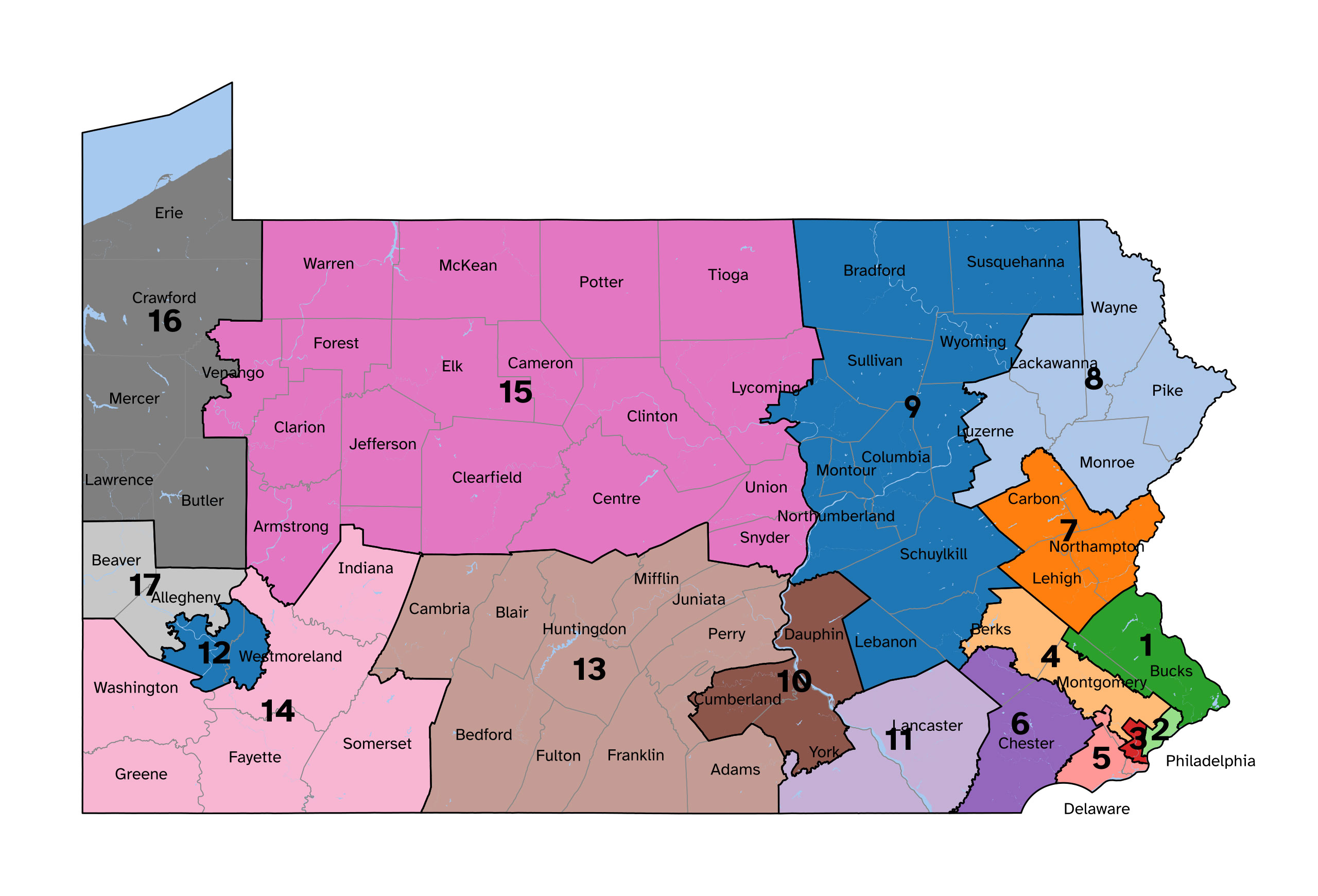News & Politics
What America’s ongoing redistricting war could mean for Pennsylvania
Pennsylvania is unlikely to redraw congressional maps mid-decade, but that doesn’t negate the need for redistricting reforms, advocates say.

President Donald Trump successfully pushed Texas Gov. Greg Abbott for a new, GOP-friendly congressional map in the state. CHIP SOMODEVILLA/GETTY IMAGES
A political war over congressional redistricting is underway in the United States.
Under pressure from President Donald Trump, Texas state lawmakers took the highly unusual step to redraw the state’s congressional maps in the middle of the decade. The move is part of a concerted effort by the GOP to pick up more House seats – and expand its slim majority in Congress. That prompted a retaliatory effort in California, where lawmakers are seeking to temporarily bypass the state’s independent redistricting commission to pass a Democrat-friendly congressional map through a ballot initiative.
With Pennsylvania a perennial focal point during elections, the current cartographic chaos over redistricting in other states begs the question: Will the Keystone State become the next battleground?
To determine the answer, it’s important to first understand the national fight over congressional districts, the process by which Pennsylvania last selected its own congressional map, and the political dynamics at play in the state Capitol.
The redistricting war is here
The national fight over congressional maps began over the summer in Texas at the urging of Trump and his team. The Texas Tribune reported in July that Texas Gov. Greg Abbot was initially hesitant about a mid-decade effort to redraw the Lone Star State’s congressional maps, as was the state’s GOP congressional delegation.
However, White House staffers continued to discuss the possibility with Abbott, with Trump calling him to push for redistricting. Following that call, Abbott put the issue on the agenda for a special session, which resulted in a new congressional map that Abbott signed into law in August. Trump has said publicly that Republicans are “entitled to five more seats” in Texas.
The effort drew extreme pushback from Democrats in Texas and across the country. Prior to the enactment of the new map, Democratic state legislators fled the state to block the proposed congressional map from advancing. Since being signed into law, the map has drawn lawsuits from organizations like the NAACP and the League of United Latin American Citizens, both of which argue that the maps are racially discriminatory.
Carol Kuniholm, the chair of Fair Districts PA, a nonpartisan advocacy organization that pushes for redistricting reforms in Pennsylvania, told City & State that Fair Districts PA members are “alarmed and disheartened” to see what’s playing out nationally with redistricting.
“It seems clearly wrong to say we are going to redistrict a state mid-decade to try to get more seats for one party or another. To have the president do this as a matter of policy, to say we want states to redistrict so that we get more Republicans in Congress is really, really alarming,” she said.
In response to the Texas effort, California Gov. Gavin Newsom, a Democrat, introduced a proposal for a new congressional map in California. “California and Californians have been uniquely targeted by the Trump Administration, and we are not going to sit idle while they command Texas and other states to rig the next election to keep power – pursuing more extreme and unpopular policies,” Newsom said in mid-August.
Newsom’s initiative, which was approved by California lawmakers and signed into law by the Democratic governor, is a constitutional amendment that gives Californians the opportunity to adopt a new, temporary congressional map that would replace the map created by the state’s citizens’ redistricting commission through 2030.
Newsom said the ballot initiative, known as Proposition 50, would “bring much-needed accountability to Trump’s efforts to undermine the democratic process.” Voters will decide on whether to approve the constitutional amendment on Nov. 4.
Kuniholm also expressed concerns with efforts by California politicians to effectively press pause on its citizens' redistricting commission. “It’s proven to be really effective. Voters have been really pleased with how it’s worked,” she said. “There’s been much less litigation, and voters feel like they're better represented. So it’s really disheartening to see that be threatened as this redistricting war unfolds.”
Missouri lawmakers also decided to get in on the action, with Gov. Mike Kehoe, a Republican, expected to sign a congressional map approved by state lawmakers that would give the GOP an additional seat in the state. Other states exploring a potential redraw of their congressional districts include Ohio, Indiana, Maryland, Florida and Illinois, according to The Hill.
Mapping out Pennsylvania’s future
So, where does all this leave Pennsylvania?
The commonwealth’s most recent congressional map was selected by the Pennsylvania Supreme Court in 2022 after a drawn-out legal battle that took place after then-Gov. Tom Wolf vetoed a proposed map sent to him by Republican lawmakers.
The final map, known as the Carter Plan, divided the commonwealth into 17 congressional districts – one seat fewer than the previous map, as Pennsylvania ended up losing a seat following the most recent U.S. census.
It’s no secret that Pennsylvania is politically divided, but in this rare occurrence, the state’s political division could actually save the state from going down the path of Texas, California and Missouri, where lawmakers and other government officials are looking to advance new maps for partisan gain.

“There’s one special reason why there’s not going to be anything in Pennsylvania, and that’s because Pennsylvania is one of only, I think, two states in the country that has a divided government,” said Jonathan Cervas, a professor at Carnegie Mellon University who specializes in redistricting and voting rights.
“There’s been a stalemate on even passing the basic state budget. So the idea that we would have an agreement from both branches of the legislature and the governor on a new redistricting plan seems very unlikely – exceedingly unlikely.”
The Pennsylvania General Assembly has only become further divided since 2022, when both the state House and state Senate were controlled by Republicans. Since that time, Democrats have flipped the state House; they currently have a one-seat advantage over the Republican minority.
Senate Majority Leader Joe Pittman, a Republican, made a similar comment to investigative outlet Spotlight PA when asked about the possibility of a mid-decade redistricting effort in Pennsylvania. Pittman said, “The realities of divided government make this a non-issue.”
That’s not to say Pennsylvania is totally out of the woods. Kuniholm said that while Pennsylvania is “protected by that Supreme Court majority and by our divided government” for the time being, the state should still seek reforms to its map-drawing processes.
“That’s not a guarantee for the future. We know in the past Pennsylvania was a top target in gerrymandering efforts, and we know that that could happen again if protections aren’t put in place,” she said.

Fair Districts PA continues to push for an amendment to the Pennsylvania constitution that would do away with the current method of drawing congressional maps. Currently, lawmakers in the General Assembly introduce and vote on the maps, with the governor having the ability to either sign or veto the proposal. Instead, the organization would like to see an independent citizens' commission put in place to remove politicians from the process altogether.
“The bills that we are supporting would put an independent commission in place, and that would be a genuine independent commission, not selected by legislators, not answering to legislators – the map would not need to be approved by legislators,” Kuniholm said.
There are a few scenarios that could change the political calculus in Pennsylvania when it comes to drawing congressional districts.
Cervas noted that Republicans could theoretically reclaim united government in Pennsylvania if they win the governor’s office in 2026, along with a few state House seats.
“You could imagine that maybe Republicans pick up a couple of seats in the House, and they're running a formidable candidate for governor, Stacy Garrity. She could win, and then they would have a united government,” Cervas said. He added that such a dynamic in Harrisburg could change the appetite for exploring the possibility of a new map in the middle of the decade. However, that scenario wouldn’t be feasible until after the 2026 midterms, and redrawing congressional districts before then would do little to help vulnerable incumbents.
Separately, given that Pennsylvania’s Supreme Court has played an outsized role in selecting the state’s congressional maps in recent decades – the court threw out the state’s 2011 congressional map in 2018, and ended up selecting the final map in 2022 – this year’s retention elections for the Pennsylvania Supreme Court could have a major effect on the makeup of the court in the years to come.
Voters will have the option this fall to retain three justices – Christine Donohue, Kevin Dougherty and David Wecht – for new 10-year terms. If they don’t, that could provide an opportunity for conservatives to expand their influence on the high court in the coming years.
